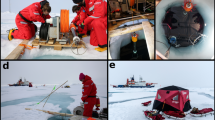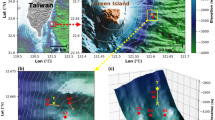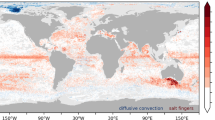Abstract
The Southern Ocean is thought to be one of the most energetic regions in the world’s oceans. As a result, it is a location of vigorous diapycnal mixing of heat, salt and biogeochemical properties1,2,3. At the same time, the Southern Ocean is poorly sampled, not least because of its harsh climate and remote location. Yet the spatial and temporal variation of diapycnal diffusivity in this region plays an important part in the large-scale ocean circulation and climate4,5,6. Here we use high-resolution hydrographic profiles from Argo floats in combination with the Iridium communications system to investigate diapycnal mixing in the Southern Ocean. We find that the spatial distribution of turbulent diapycnal mixing in the Southern Ocean at depths between 300 and 1,800 m is controlled by the topography, by means of its interaction with the Antarctic Circumpolar Current. The seasonal variation of this mixing can largely be attributed to the seasonal cycle of surface wind stress and is more pronounced in the upper ocean over flat topography. We suggest that additional high-resolution profiles from Argo floats will serve to advance our understanding of mixing processes in the global ocean interior.
This is a preview of subscription content, access via your institution
Access options
Subscribe to this journal
Receive 12 print issues and online access
$259.00 per year
only $21.58 per issue
Buy this article
- Purchase on Springer Link
- Instant access to full article PDF
Prices may be subject to local taxes which are calculated during checkout




Similar content being viewed by others
References
Sarmiento, J. L. & Toggweiler, J. R. A new model for the role of the oceans in determining atmospheric pCO2 . Nature 308, 621–624 (1984).
Heywood, K. J., Naveira Garabato, A. C. & Stevens, D. P. High mixing rates in the abyssal Southern ocean. Nature 415, 1011–1014 (2002).
Gregory, J. M. Vertical heat transports in the ocean and their effect on time dependent climate change. Clim. Dyn. 16, 501–515 (2000).
Polzin, K., Toole, J., Ledwell, J. & Schmitt, R. Spatial variability of turbulent mixing in the abyssal ocean. Science 276, 93–96 (1997).
Saenko, O. & Merryfield, W. On the effect of topographically enhanced mixing on the global ocean circulation. J. Phys. Oceanogr. 35, 826–834 (2005).
Wunsch, C. & Ferrari, R. Vertical mixing, energy and the general circulation of the oceans. Annu. Rev. Fluid Mech. 36, 281–412 (2004).
Huang, R. X. Mixing and energetics of the oceanic thermohaline circulation. J. Phys. Oceanogr. 29, 727–746 (1999).
Zhang, J., Schmitt, R. W. & Huang, R. X. The relative influence of diapycnal mixing and hydrologic forcing on the stability of the thermohaline circulation. J. Phys. Oceanogr. 29, 1096–1108 (1999).
Jayne, S. R. The Impact of abyssal mixing parameterizations in an Ocean General Circulation Model. J. Phys. Oceanogr. 39, 1756–1775 (2009).
Naveira Garabato, A. C., Polzin, K. L., King, B. A., Heywood, K. J. & Visbeck, M. Widespread intense turbulent mixing in the Southern Ocean. Science 303, 210–213 (2004).
Sloyan, B. M. Spatial variability of mixing in the southern ocean. Geophys. Res. Lett. 32, L18603 (2005).
Kunze, E., Firing, E., Hummon, J. M., Chereskin, T. K. & Thurnherr, A. M. Global abyssal mixing inferred from lowered ADCP shear and CTD strain profiles. J. Phys. Oceanogr. 36, 1553–1576 (2006).
Polzin, K. L. & Firing, E. International WOCE Newsletter, No. 29, WOCE International Project Office, Southampton, United Kingdom, 39–42 (1997).
Ledwell, J. R., St Laurent, L. C., Girton, J. B. & Toole, J. M. Diapycnal mixing in the Antarctic Circumpolar Current. J. Phys. Oceanogr. 41, 241–246 (2011).
Jing, Z. & Wu, L. Seasonal variation of turbulent diapycnal mixing in the northwestern Pacific stirred by wind stress. Geophys. Res. Lett. 37, L23604 (2010).
Gregg, M. C., Sanford, T. B. & Winkel, D. P. Reduced mixing from the breaking of internal waves in equatorial ocean waters. Nature 422, 513–515 (2003).
Finnigan, T., Luther, D. & Lukas, R. Observations of enhanced diapycnal mixing near the Hawaiian Ridge. J. Phys. Oceanogr. 32, 2988–3002 (2002).
Thompson, A. F., Gille, S. T., MacKinnon, J. A. & Sprintall, J. Spatial and temporal patterns of small-scale mixing in Drake Passage. J. Phys. Oceanogr. 37, 572–592 (2007).
Alford, M. H. Improved global maps and 54-year history of wind work on ocean inertial motions. Geophys. Res. Lett 30, 1424 (2003).
Bell, T. H. Topographically generated internal waves in the open ocean. J. Geophys. Res. 80, 320–327 (1975).
Nikurashin, M. & Ferrari, R. Radiation and dissipation of internal waves generated by geostrophic motions impinging on small-scale topography: Application to the Southern Ocean. J. Phys. Oceanogr. 40, 2025–2042 (2010).
Wunsch, C. The work done by the wind on the oceanic general circulation. J. Phys. Oceanogr. 28, 2332–2340 (1998).
Klymak, J. M., Pinkel, R. & Rainville, L. Direct breaking of the internal tide near topography: Kaena Ridge, Hawaii. J. Phys. Oceanogr. 38, 380–399 (2008).
Sprintall, J. Seasonal to interannual upper-ocean variability in the Drake Passage. J. Mar. Res. 61, 27–57 (2003).
Danioux, E., Klein, P. & Rivière, P. Propagation of wind energy into the deep ocean through a fully turbulent mesoscale Eddy field. J. Phys. Oceanogr. 38, 2224–2241 (2008).
Zhai, X., Greatbatch, R. J., Eden, C. & Hibiya, T. On the loss of wind-induced near-inertial energy to turbulent mixing in the upper ocean. J. Phys. Oceanogr. 39, 3040–3045 (2009).
Zhai, X., Greatbatch, R. J. & Zhao, J. Enhanced vertical propagation of storm-induced near-inertial energy in an eddying ocean channel model. Geophys. Res. Lett. 32, L18602 (2005).
Kunze, E. Near-inertial propagation in geostrophic shear. J. Phys. Oceanogr. 15, 544–565 (1985).
Polzin, K. L., Toole, J. M. & Schmitt, R. W. Finescale parameterizations of turbulent mixing. J. Phys. Oceanogr. 25, 306–328 (1995).
Osborn, T. R. Estimates of the local rate of vertical diffusion from dissipation measurements. J. Phys. Oceanogr. 10, 83–89 (1980).
Acknowledgements
This work is supported by China National Natural Science Foundation (NSFC) Outstanding Young Investigator Project (40788002), National Key Basic Research Program (2007CB411800), and NSFC Creative Group Project (40921004). We thank the International Argo (Array for Real-time Geostrophic Oceanography) Observational Program for providing data through the open access (http://wo.jcommops.org/cgi-bin/WebObjects/Argo.woa/wa/ptfSearch). Finally, we thank E. Kunze for an insightful explanation about abyssal mixing inferred from lowered ADCP shear and CTD Strain profiles.
Author information
Authors and Affiliations
Contributions
L.W. and Z.J. made equal contributions to the paper. L.W. contributed to the central idea and organized the writing of the paper. Z.J. performed the data analysis and contributed to writing of the paper. S.R. and M.V. offered guidance in analyses of the Argo profiling data and mixing, and contributed to the editing of this paper.
Corresponding author
Ethics declarations
Competing interests
The authors declare no competing financial interests.
Rights and permissions
About this article
Cite this article
Wu, L., Jing, Z., Riser, S. et al. Seasonal and spatial variations of Southern Ocean diapycnal mixing from Argo profiling floats. Nature Geosci 4, 363–366 (2011). https://doi.org/10.1038/ngeo1156
Received:
Accepted:
Published:
Issue Date:
DOI: https://doi.org/10.1038/ngeo1156
This article is cited by
-
Past and future ocean warming
Nature Reviews Earth & Environment (2022)
-
Geographical inhomogeneity and temporal variability of mixing property and driving mechanism in the Arctic Ocean
Journal of Oceanology and Limnology (2022)
-
Seasonal and interannual variability of vertical turbulent exchange coefficient in the Black Sea pycnocline in 2013–2016 and its relation to variability of mean kinetic energy of surface currents
Ocean Dynamics (2020)
-
Spatial and seasonal variability of global ocean diapycnal transport inferred from Argo profiles
Journal of Oceanology and Limnology (2019)
-
A statistic of water mass intrusions in the south Indian Ocean between 100° E and 110° E
Ocean Dynamics (2019)



